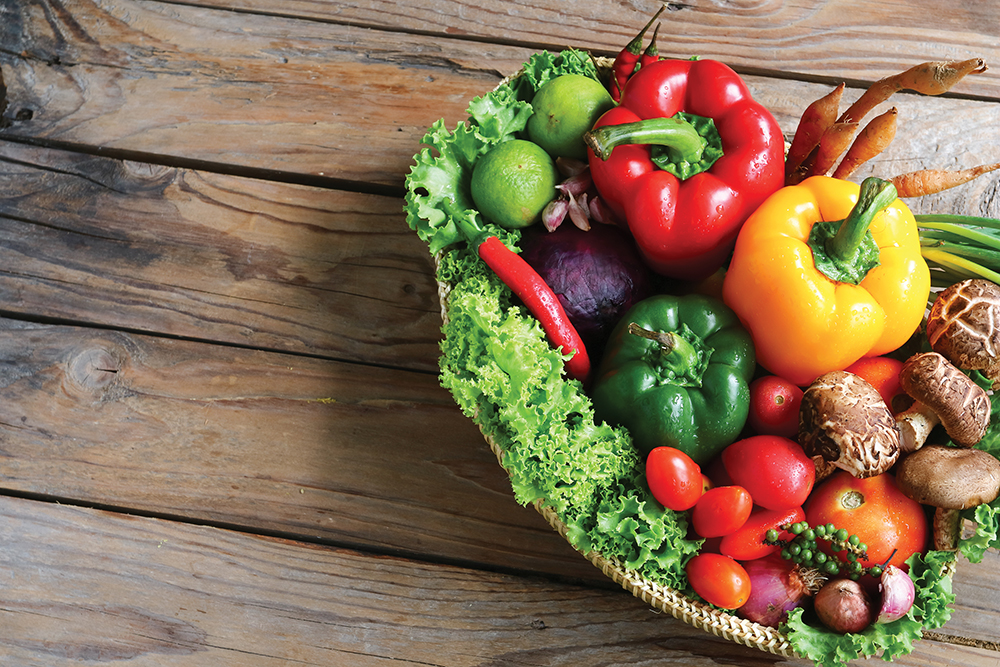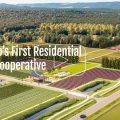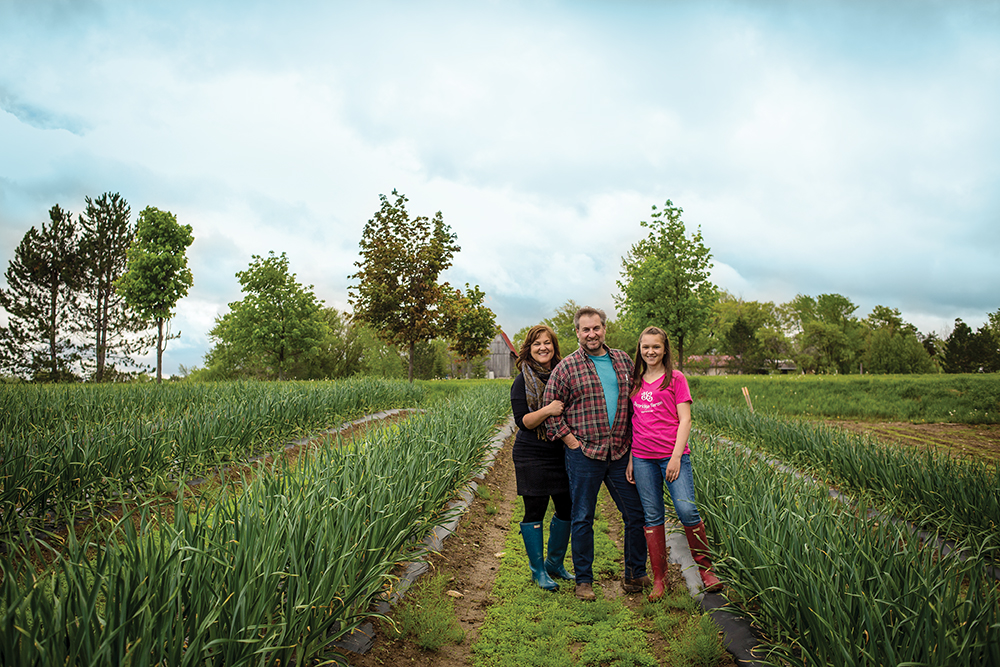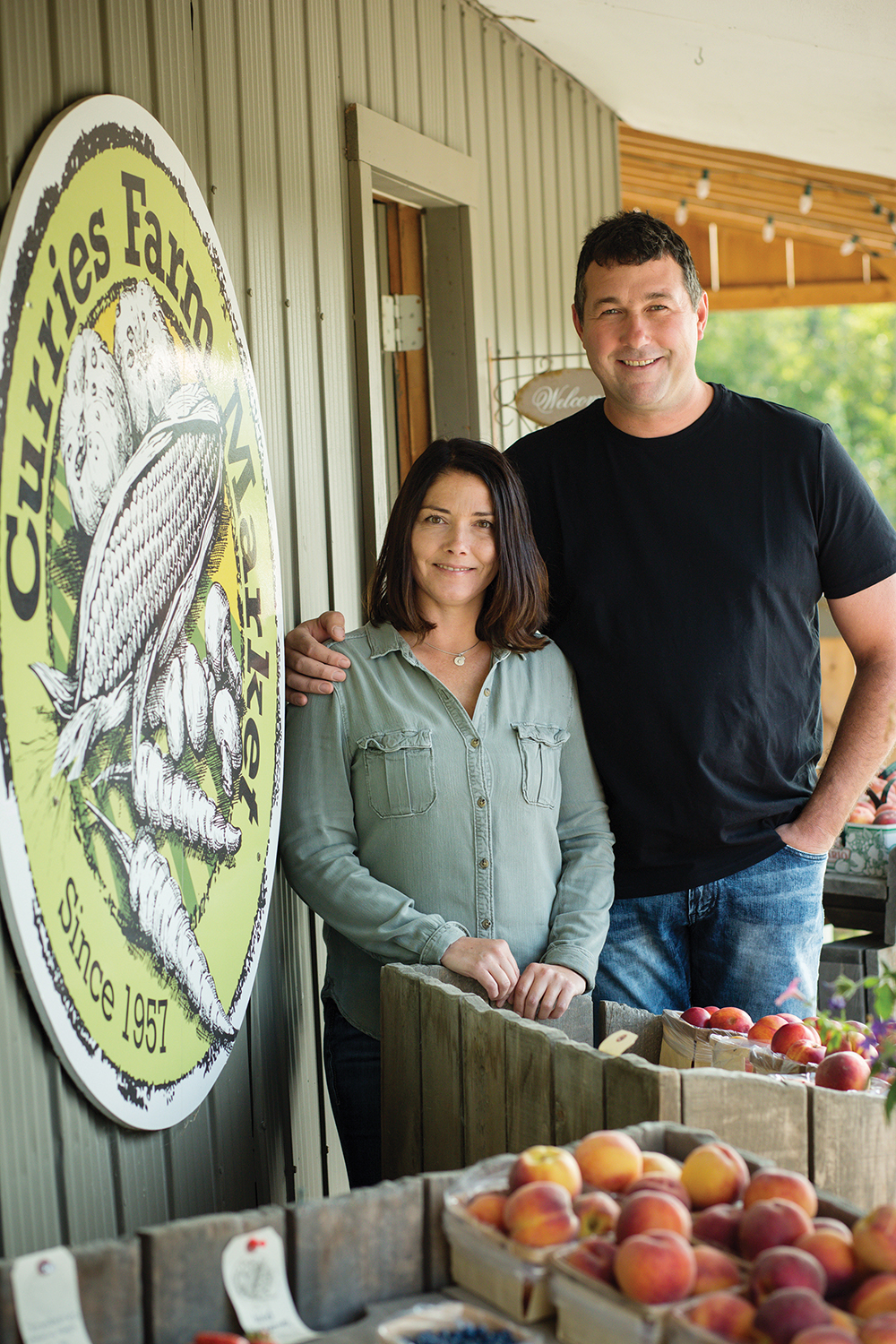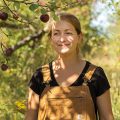With the harvest comes an appreciation of the work that produces what we eat and drink.
stories by Emily Worts
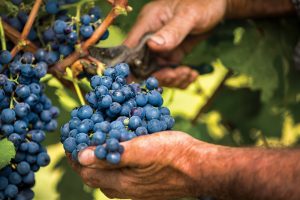 The sun is shining October bright, producing heat without sweat; a warm caress on my back. The landscape is sweeping – vineyards in the foreground, the Escarpment falling into the Bay, the Collingwood grain elevator a landmark on the horizon. I am volunteering to pick grapes just north of Creemore along with about 40 others. Some of us have ducked out of work to take a day and enjoy the last of the sun’s heat; many are retired, here to enjoy the physical work and the camaraderie. I am picking grapes across from strangers, sharing different sides of the same vine. As we pick, we talk of writing, of bee keeping and of growing garlic. It’s an inspirational setting and between conversations, we dream.
The sun is shining October bright, producing heat without sweat; a warm caress on my back. The landscape is sweeping – vineyards in the foreground, the Escarpment falling into the Bay, the Collingwood grain elevator a landmark on the horizon. I am volunteering to pick grapes just north of Creemore along with about 40 others. Some of us have ducked out of work to take a day and enjoy the last of the sun’s heat; many are retired, here to enjoy the physical work and the camaraderie. I am picking grapes across from strangers, sharing different sides of the same vine. As we pick, we talk of writing, of bee keeping and of growing garlic. It’s an inspirational setting and between conversations, we dream.
This isn’t back-breaking work, but it is physical and it feels good. People arrive at different times, but everyone has agreed to work a six-hour day. The grapes are clustered in convenient little bundles that are easy to snip off with the pruners I brought. I place each bundle gently into a basket at my feet and clip another.
Taking a break, I bite into one of the crunchy yellow apples delivered by the bushel to the end of each row of grapes to revive the increasingly fatigued workers. The apples were grown on this farm and their short trip from tree to mouth, combined with my hours of labour, ensure that this is one of the sweetest apples I’ve ever tasted. At the noon hour we are called up to an old Ontario barn where large tables have been placed for a simple but satisfying lunch of chili, salad, pumpkin pie and, of course, wine – Pinot Grigio and Baco Noir are on the table, both showcasing the grapes we have been picking all morning. The wine is sophisticated and fresh. With a lighter head and a fuller belly we return to the vineyard in search of empty baskets and more vines laden with grapes.
This is the first time I have done anything like this since my twenties, when I backpacked around New Zealand, stopping in various towns and cities while intermittently volunteering on farms and in farm-based hostels through the WWOOF (World Wide Opportunities on Organic Farms) program. In exchange for four to six hours of work I was given three meals (usually sourced from the farm) and a bed, often in a unique and spectacular home. For me, this was a means of travel; it made my adventures possible, and it maintained my bank account so I could continue to explore. But the experience also introduced me to the world of food from a whole new perspective. Up until that point I had spent my summers working in kitchens preparing all sorts of dishes, but never before had I been part of any real food-growing experience. What I discovered was that, more than simply an exchange of labour for room and board, I was the beneficiary of culture and knowledge beyond my expectations.
The WWOOF program is popular around the world, including Southern Georgian Bay. Farms usually request that you stay longer than lunch, and commitments can last from a couple of days to a few months.
Food ‘experiences’ have been gaining in popularity since the late 1980s. Farmer’s markets have become the social backbone for many small Ontario communities. Food and drink festivals dot the tourist map all over the province. Berry farms and pumpkin patches do a booming trade in pick-your-own, while food trails such as our own Apple Pie Trail traverse some of the most scenic bike and car routes our province has to offer.
But why are these ‘experiences’ so popular? People are surprisingly willing to ‘work’ on their vacations, in exchange for an experience. And food involves work. It can be dirty, painful, hot and uncomfortable to get a harvest of carrots onto the table or grapes into a bottle. When we choose our carrots either from the shelves of the grocery store or the stall at the farmer’s market, or pluck the bottle of Pinot from the shelves at the LCBO, we often fail to recognize the work that went into producing them. The carrots get sliced, diced and gobbled up with little regard for the land and people who nurtured them. The complexity of the grape and the stages of the wine-making process might be contemplated for the first sip or two, but seldom do we think of the farmers who lovingly cultivated the grapes themselves. We eat more, drink more and think less about how it all ends up on our table.
We are all searching. And one of the things many of us are seeking is a connection to the land that feeds us; a connection that is so disturbingly absent in the lives so many of us lead today. We can begin getting back to the land with more experiences that get us outside to ‘do the work.’ Such experiences can be found across the globe, from casual harvesting festivals where you can jump in for an evening and stomp on some grapes to formal work-for-room-and-board exchanges (the idea is so popular now that some vineyards and farms charge for the privilege of working on their property).
Increasingly these opportunities are showing up on local farms, at cutting-edge inns and bed and breakfasts (where you can harvest your own eggs for brunch) in our area. Mad Maple Country Inn & Agrotourismo in Creemore is one such B&B. The term Agritourismo, introduced to me by Miriam Streiman, owner and chef at Mad Maple (and one of the most passionate people I have ever met when it comes to growing, harvesting, producing, consuming and fighting for good food) is a combination of the words for agriculture and tourism in Italian. It defines a style of vacationing, usually in a farmhouse retreat, usually serving foods prepared from items grown on the farm and usually allowing guests to participate in the harvesting of these foods or in other activities around the farm. Agritourismo supplements the income of small-scale farmers while educating consumers about where their food comes from.
Our connections to food (and drink) can be limited, but there is opportunity all around us to expand our knowledge, understanding and appreciation of the food chain that nourishes our bodies, minds and souls. For me, food in all its forms, from seed to table, is a spiritual pursuit: through food, I connect to the higher order of things, take care of those around me, heal myself, quiet my mind and slow down. Food is how I define myself as a human being.
Spending an afternoon working on a vineyard was, for me, a gift and a pleasure. To taste the fruits of my labour and that of others before me heightened the flavour of the wine and enriched the ceremony of consumption. There is something so very romantic, and for many of us so very spiritual, about witnessing and being part of a harvest, which makes us appreciate the land that provides its bounty so that we may live, share and enjoy. I highly recommend the experience. ❧
Apple Harvest
Pick Your Own!
Picking apples is an essential part of living in apple country. With several pick-your-own operations scattered throughout the region, taking the whole family out for a few hours of apple picking is perhaps the best and easiest way to experience the harvest and appreciate the work growers and pickers put in to bring a wide selection of crunchy, delicious apples to our tables.
Every fall my family heads out to Giffen’s Country Market and Orchards in Glen Huron to pick a variety of apples growing along the hillside. We pick apples for school lunches, apples for baking, and apples that are tucked away in our basement cold storage for snacking throughout the year.
I have never mastered the perfect pie crust, so when it comes to baking with apples I stick to crumbles, crisps and have begun experimenting with apple bread. My favourite apple crisp has morphed through the years and seasons to include different nuts and seeds as well as seasonal fruits and berries in addition to apples (I add cranberries around Thanksgiving) and various spices (like cardamom). Here is the basic recipe, but feel free to add or substitute to suit your tastes.
Nutty Apple Crisp
Topping:
- 6 Tbsp. flour
- ¼ cup packed brown sugar
- ¼ cup granulated sugar
- ¼ tsp. ground cinnamon
- ¼ tsp. ground nutmeg
- ¼ tsp. salt
- 5 Tbsp. butter, chilled and cut into small ½-inch cubes
- ¾ cup coarsely chopped nuts (walnuts, pecans, almonds – choose one or mix them up)
Filling:
- 3 pounds apples – peeled, quartered, cored and cut into 1-inch chunks
- ¼ cup granulated sugar
- Juice and zest from one lemon
- Pulse flour, sugars, spices and salt in a food processor. Add butter and pulse until the mixture has the consistency of coarse cornmeal. Add the nuts and pulse again, four or five times. Topping should look like wet sand with clumps of nuts. Do not over-mix or topping will be too wet. Refrigerate topping while you prepare the filling.
- Turn oven on to 375 degrees F.
- Mix filling ingredients and scrape with a rubber spatula into 8-inch square or 9-inch deep dish. Spread chilled topping mix over filling.
- Bake for 45 minutes or until fruit is bubbling and topping is golden brown.
Serve warm with vanilla ice cream, whipped cream or sharp cheddar cheese.






